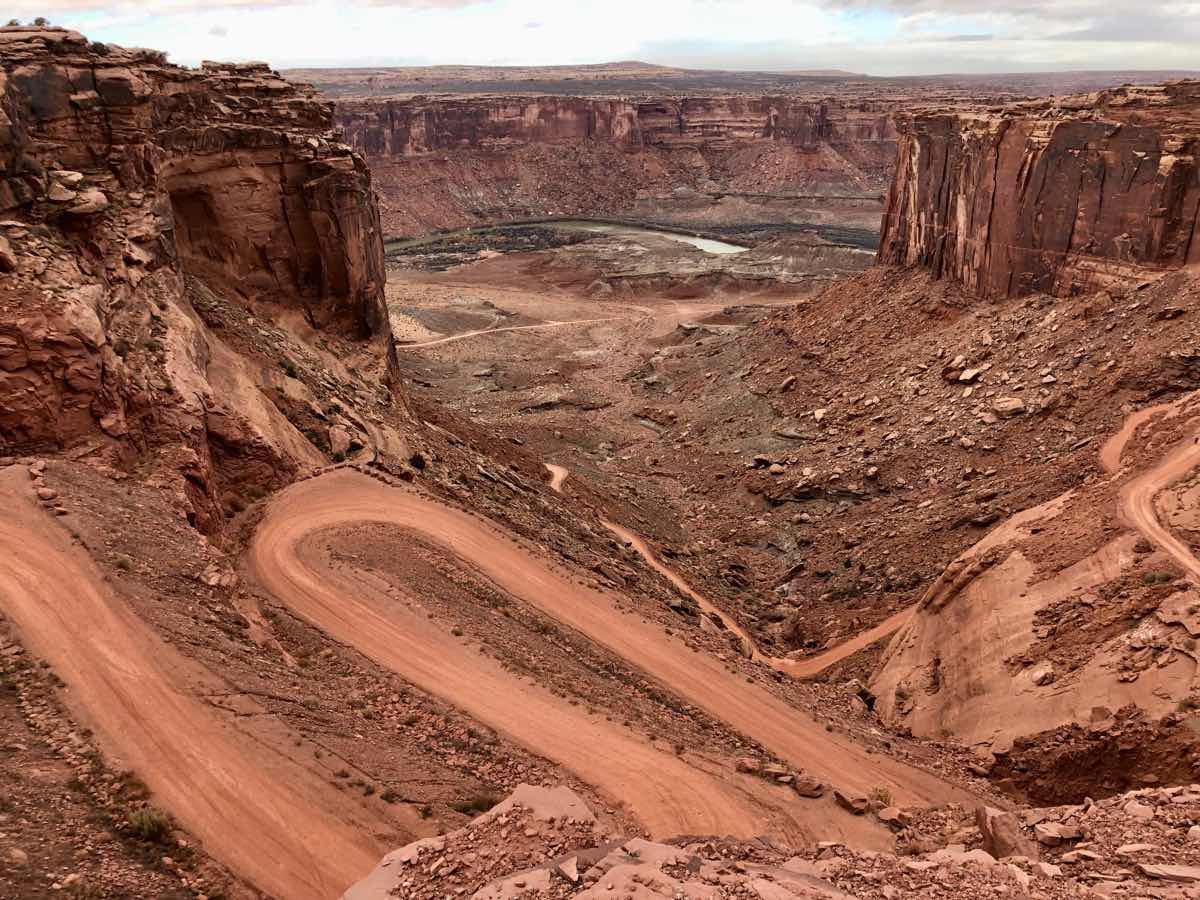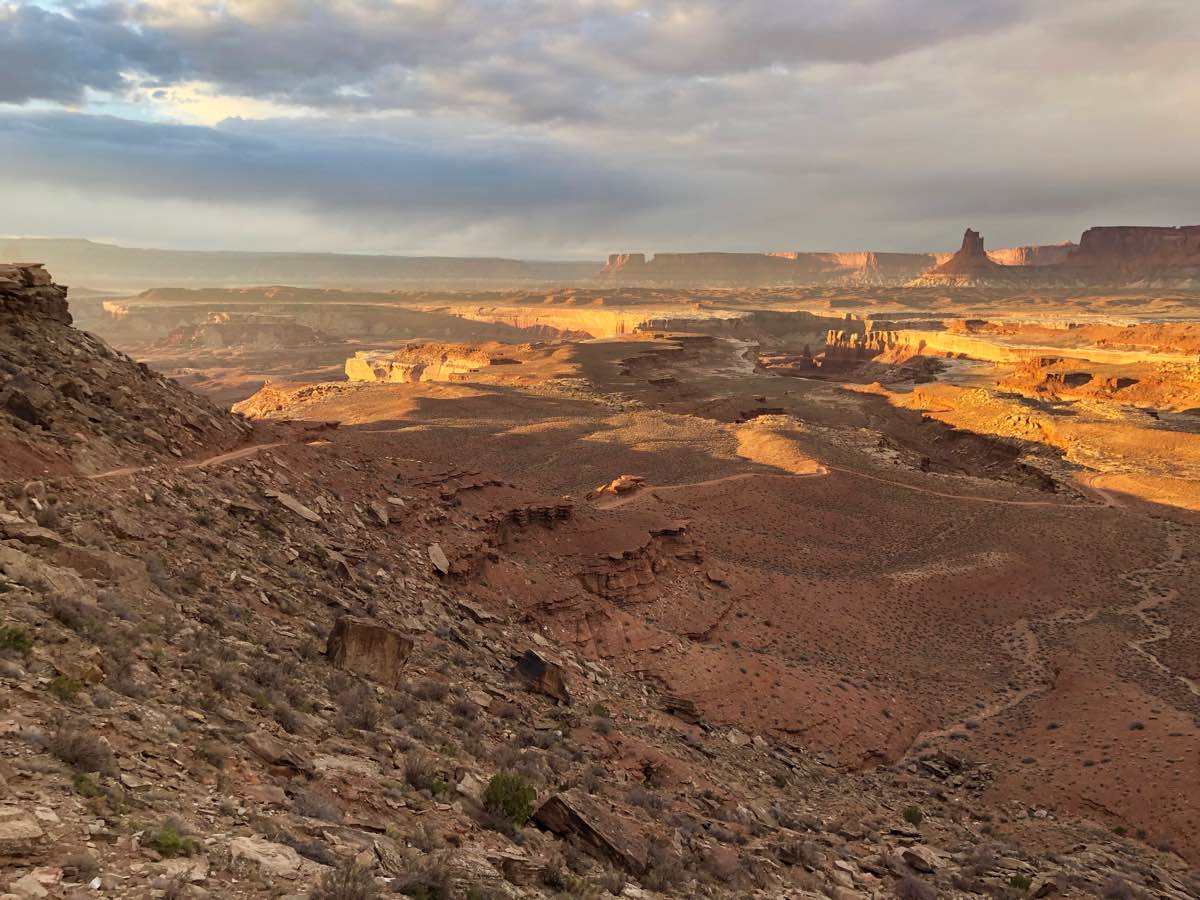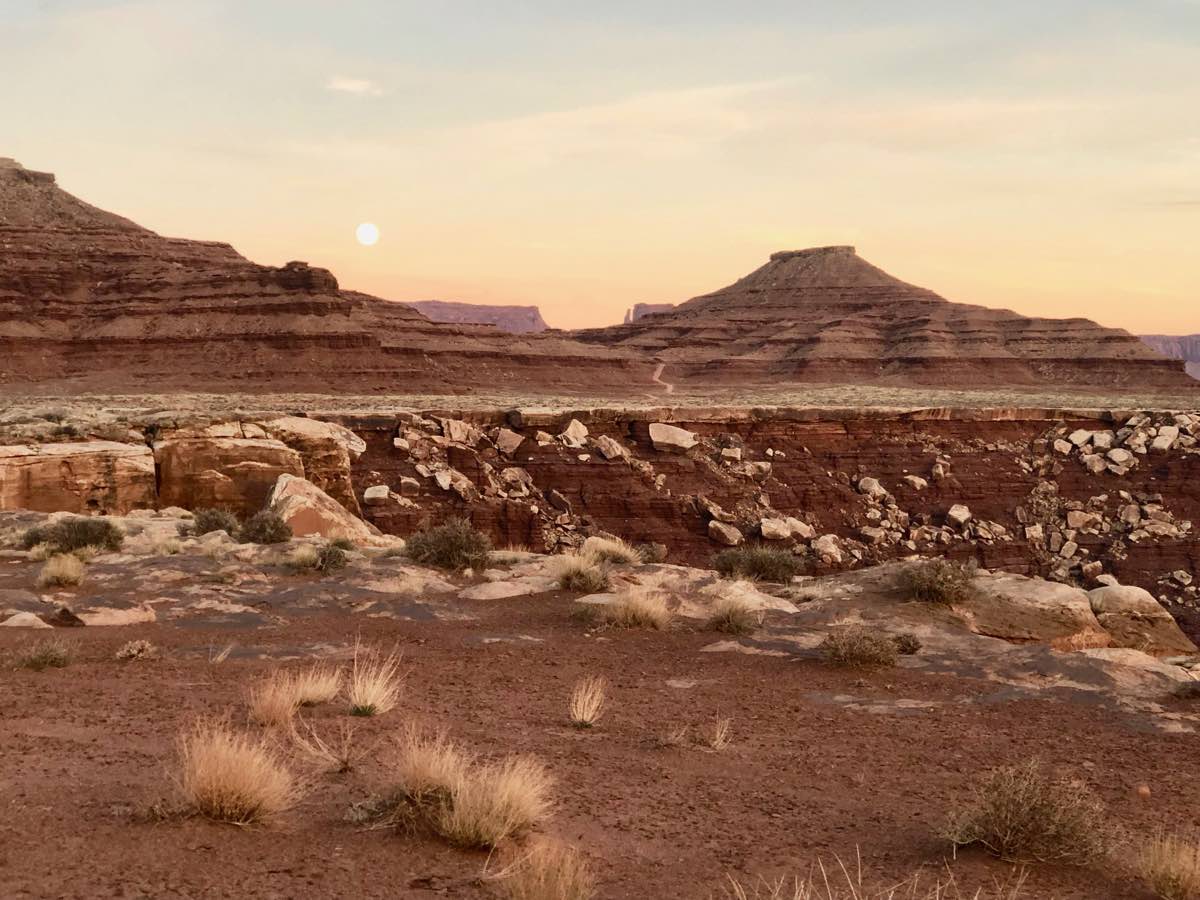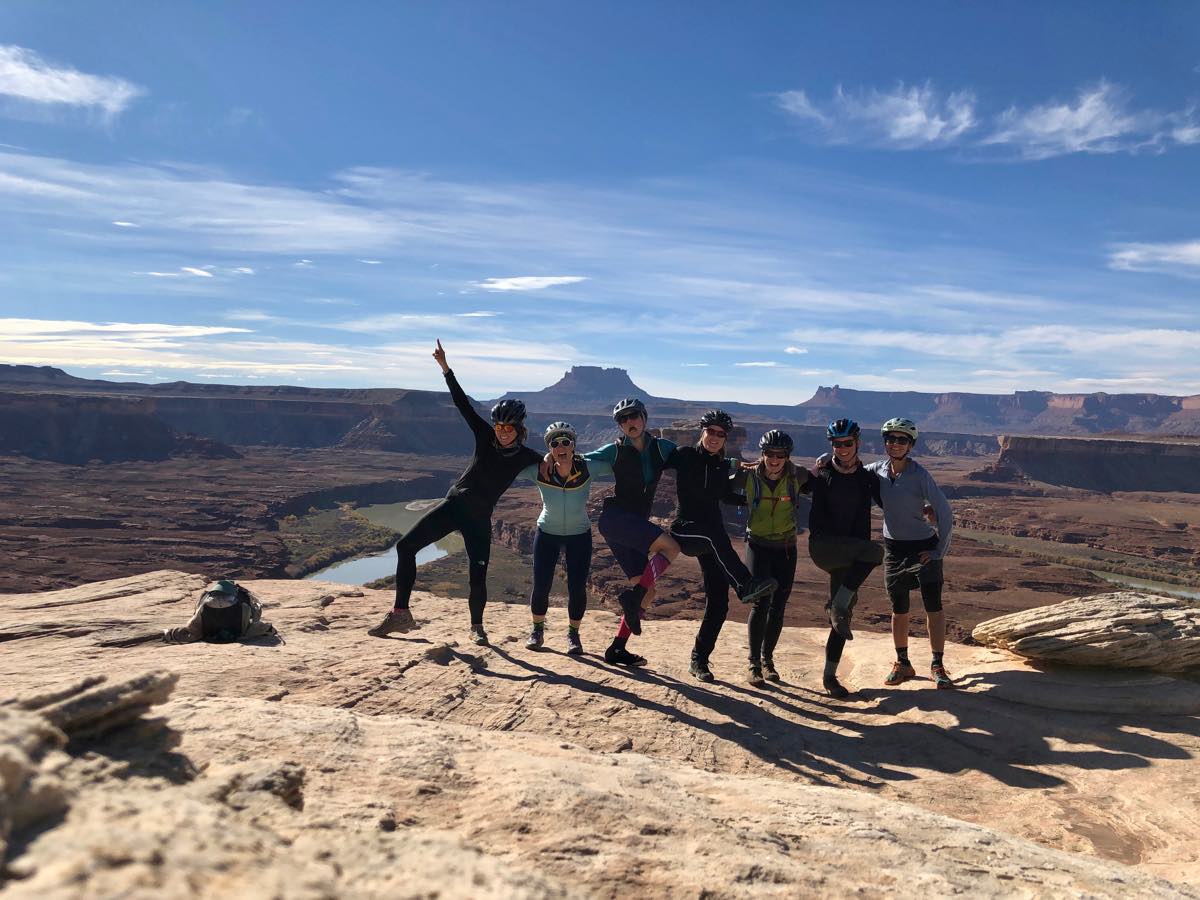[Editor’s Note: In 2018 alone, we’ve added new columns from Liza Howard and Brendan Leonard, Sabrina Little, David Laney, Morgan Tilton, and, now, a new column, ‘The Collective We,’ written by Managing Editor Meghan Hicks. If you want to help get behind these additions and those we have in store for 2019, please consider supporting iRunFar now during our year-end fund drive.]
We stand upon a precipice, the rusted, red earth dropping away abruptly. The rocks below us are a tall stack of pancakes, each layer a riff of Martian red. Everywhere else is a swirling vacuum of air and space and a sensation of nothingness and everythingness all at the same time. In more tangible terms, we’re at a scenic overlook, looking out into Utah’s canyon country. In a scene that inspires contemplation and conversation, we fall easily into both. We speak about the view, our respective forms of recreation this coming weekend, how the bright sunshine feels so warm on our skin on this shivery, late-fall morning, and how we feel lucky to be here.
This weekend, my friend Melissa Beaury and I (and our five other friends scattered about this parking lot who are, like us, preparing gear at their cars) are bikepackers undertaking a four-day self-supported trip on Canyonlands National Park’s iconic, 100-mile White Rim Trail. Our conversation partners, their car parked next to us, are a young couple and an energetic herding-breed dog wearing its own jacket. They are BASE jumpers camping here and using the cliffs below as their, ahem, base.
Our chat trends toward public lands, their intrinsic value, and their value to each of us. A slackline festival has brought hundreds of people into the open space immediately surrounding us and this parking lot is chock full of BASE jumpers who’ve set up camp to stay for days and play. I remark about the huge use changes which have come about in this very place during the last couple of years and how we’re in a “new age of recreationalism” where, because there are so many of us now, we may need to use greater care for the land and each other.
The man prickles and says, “It should be live and let live. I do what I want. You do what you want. That’s what public lands are for, right?”
The mood goes as chilly as the morning air. I am paraphrasing—I am a vacationist not a journalist this weekend so I don’t record our precise exchange—but this conveys what happened. And, to be even more clear, my sentiment isn’t my own invention. I’m reading Desert Cabal, a book by Amy Irvine, and my words are a synthesis of one of Irvine’s main arguments, where she advocates for a new vision of wild spaces as places of solidarity not solitude. She says there are too many of us for anyone to act independently anymore.
Without our conversational link, the four of us humans go about our respective machinations separately. Only the couple’s herding dog mixes between us–as herders are forever wont to do. I pat the dog’s head, feeling regretful that I unintentionally shut down what was otherwise a nice discussion. I can’t make up my mind about whether it’s the very idea of self-examination that is problematic, or my delivery of it. I think, I have so much to learn and we have so much to do.
In not too many more minutes, my six friends and I climb aboard our bikes, laden with the food, camping equipment, and warm clothes we need to spend a long weekend riding and camping along the White Rim Trail. The first 14 miles are along the Mineral Bottom Road. We share it with a significant volume of traffic, more sedans, vans, and pick-up trucks than I’ve ever seen on this road. When a vehicle approaches, we bikers accordion out to single file on the edge of the road before squishing back into our social riding group after it passes.
Some people slow as they approach us, easing by, rolling down their windows, and exchanging thumbs ups, hellos, and smiles with us. Others move fast along the washboarded dirt road. You can see the enormous dust clouds they kick up a mile or two out. They whiz past, their vehicles rattling hard, and we are engulfed by their red dust clouds for a minute or so. We comment in surprise about how fast some of the cars go so far out in this remote location, and how their occupants either don’t realize or care that they are dusting the other humans with which they share the road.
Melissa develops a brave and effective solution. Instead of moving to the side of the road, she rides right in the middle and waves wildly when vehicles approach. Most of the drivers see her, slow down, and we engage in a friendly exchange that goes basically like this: “Hello,” she says, “we so appreciate you slowing down!” “Oh, you’re welcome!” they reply. “Have a nice day,” we all say.
Again with the paraphrasing, but you get my point, Melissa’s actions incite positive and mutually respectful interactions for all creatures. (The human-to-human respect is self-evident, and I’ll linger only a moment on the importance of minimizing blowing dust in desert environments. The dirt can come to rest on desert biota and, in doing so, limit their ability to photosynthesize, causing them to weaken or die.) Where I failed in the parking lot an hour ago to create a constructive experience, Melissa succeeded. I am inspired.
* * *
It was on that November day that this column ultimately grew its wings. The idea of me writing a monthly column on iRunFar has been on the brainstorm shelf for years. With some regularity, iRunFar’s Editor-in-Chief Bryon Powell would ask, “Time to write a column for iRunFar?”
For so long, my response was “no.” The truth is, I love the writing craft and I love all of you, iRunFar readers, even more. But I am terrifically afraid of judgement of my writing and, by extension, me. I am also a pacifist by genetic origin and sharing thoughts that could lead to deconstructive fighting lies in opposition to my peacekeeping nature. I realize all this is probably defective logic, but it has been my personal truth.
Now my inspiration finally exceeds my terror, and so here we all are. My mission in this column is to do the opposite of what I did in the parking lot, and exactly what Melissa did on the dirt road. I want to wave my arm, smile widely, slow us all down just a little, and provide a place for inspiration, conversation, and contemplation. A home for you, me, and the collective we to do the hard and yet graceful work of going intentionally into our future.
* * *
The first evening on the White Rim Trail, our passel of women rolls into our permitted campsite, after the sun falls below the orange cliffs looming to our west, after the night’s creeping cold swallows the warmth of the day, while the sky and land hold the pastel hues that are inexplicably inherent to desert near-winters, and as a dish-plate full moon rises over it all.
In the next crepuscular hour, we make quick work of donning all our layers, setting up our tents, and laying out our down sleeping bags so that they can puff up and insulate us through the night ahead. Then we gather in a circle, sit bones to bare earth, and cook our dinners over tiny camping stoves. The sky is black now, though it and everything else glow with the full moon’s light. We don’t need our headlamps to see our food.
We are mentally and physically sated by today’s work, some 40 miles and six hours of pedaling–and pushing at times, when the earth pitched up or the sand deepened–our bikes out into the far reaches of Canyonlands National Park. Along the way, we gawked at rock arches, windows, and pedestals. We clucked back at the curious, vocal ravens. We noticed the microscopic creatures dwelling in the soil and spoke of their important roles in this ecosystem. We stopped over and over to take in the long view, wondering just how far we could actually see.

The Green River meanders through a horseshoe bend on the White Rim Trail in Canyonlands National Park.
We are a group of friends who gather from all over the United States almost annually for an all-women backcountry adventure. We are diverse people–lawyers, biologists, farmers, writers, outdoor guides–living different lives in largely divergent worlds. No matter, our discussion dances everywhere, like tonight’s moonlight over the desert landscape. We are heart-full with each other’s company, too.
Soon, I lay my head to the earth for the night of sleep I’ve been looking forward to all week–there’s nothing like camping in a place as quiet as here to encase me in a deep and reviving sleep. Wait, I’m traveling ultralight and the ground is as hard as it gets, so let me begin again. I lay my head down, padding it with a stuff sack containing my food for the days to come and a puffy jacket. Tomorrow’s snack bars and macadamia nuts and couscous crunch beneath the weight of my skull before finally everything goes quiet again. Aside from my brain, of course. Always my brain.
As I wait for my brain waves to settle into a calm sea of sleep, I consider our current convergence and the innumerate variables that came together just so in order for it to happen: our grand luck in a popular camping-permit lottery last July, the husband who parents solo for six days so one of us can participate, our earlier circle of blue-flame stoves twinkling into the inky night, our warm-breath giggles alighted by the moon as they condense into the cold, the final quieting of the tinny ringing in our ears when all of our body systems find equilibrium in replete silence, the very existence of the 337,598 acres of Canyonlands National Park that were heavily protected by U.S. Presidential proclamation and Congressional designation back in 1964 and 1971 and are still holding their borders against the persistent pressure of humanity.
I wince at the statistical improbability of this moment. But here we are anyway, doing this, and we’ll do it again tomorrow, and the day after that, and still one more day after that.
Convergence; mergence; of nature and people and the blank space for the mind and the body and the animals who still roam wilder than our wildest dreams; where our singular souls yield to a communion of creatures both because we can and should; where inter- and intra-species solidarity among trail runners, BASE jumpers, bikepackers, jackrabbits, bobcats, and pack rats stands as solid as canyon country’s tallest cliffs and hardest earth; where the collective we let the mistaken words and whirling dust of our past settle out; where we forge our united future.
In Desert Cabal, Amy Irvine writes, “By nature, we are a cabal. A group gathered around a panoramic vision… Our most precious resource now is wonder. What we wonder about ignites our imagination, unleashes our empathy, fuels our ferocity. We fold in on ourselves, a thunderous, galloping gathering, a passionate peopled storm, nearly indistinguishable from the ground on which it rains, on which it sprinkles seeds. This is how hope takes root. What springs forth are monolithic possibilities.”
Improbable or not, we seven women laying nearly indistinguishable from the ground beneath us in the darkest dark and the quietest quiet are proof of the possible, so I hope to see you here next month.
Call for Comments
- What do you think of Amy Irvine’s argument in Desert Cabal that the outdoor community needs to develop relationships of solidarity rather than just solitude with wild places so that we can work together to protect them?
- When have you felt our trail running and ultrarunning community as a whole working for the ‘greater good?’
- What topics would you like to discuss as part of this column in the future?




